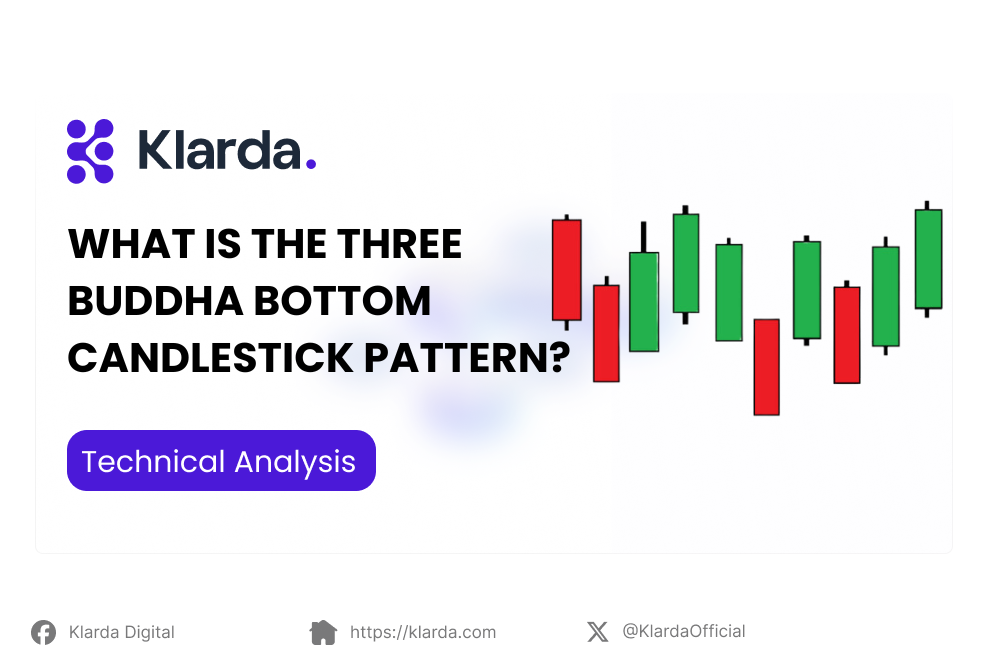What Is The Three Buddha Bottom Candlestick Pattern? How Does It Work?
The Three Buddha Bottom signaling a potential bullish reversal. For more details, see the article below.
The Three Buddha Bottom pattern, also known as The Inverted Three Buddha, occurs when the middle low is lower than both the first and third lows. This unique formation signifies a specific market behavior that can indicate a potential bullish reversal. To gain a deeper understanding of this pattern and its implications, let's explore the detailed article below.

KEY TAKEAWAY
- The "Three Buddha Bottom" is a pattern with three lows, where the middle low is the lowest, signaling a potential bullish reversal after repeated support tests.
- The Three Buddha Bottom pattern consists of three lows with the middle low being the lowest, suggesting repeated support tests and a shift from selling to buying momentum, which may signal a bullish reversal.
- To trade the Three Buddha Bottom pattern, confirm three lows with the middle being the lowest, enter long above the peak, use a stop-loss below the lowest low, set profit targets, and adjust based on price action.
- The Three Buddha Top and Bottom both feature three price levels and an inverted triangle shape, but the Top involves three peaks with the middle higher (indicating a bearish reversal), while the Bottom involves three lows with the middle lower (indicating a bullish reversal).
WHAT IS THE THREE BUDDHA BOTTOM CANDLESTICK PATTERN?
The "Three Buddha Bottom" is a price chart pattern in technical analysis and a variation of the Three Rivers pattern, featuring three equivalent price lows. However, unlike the Three Rivers, the Three Buddha Bottom has a middle low that is lower than the other two, forming a triangle shape.
This pattern indicates that the market has tested support three times, creating three equivalent lows before eventually reversing upwards. The lower middle low suggests decreasing selling strength and a shift toward buying momentum. If this pattern appears after a prolonged downtrend, it may signal to investors that buying pressure is increasing and a bullish reversal could be imminent.
FEATURES OF THREE BUDDHA BOTTOM CANDLESTICK PATTERN
The Three Buddha Bottom pattern has the following key characteristics:
- Three Lows: The pattern features three lows, with the middle one lower than the others, forming an inverted triangle.
- Support Testing: The price tests the support level three times, creating three equivalent lows before a reversal occurs.
- Lower Middle Low: The middle low is lower than the other two, indicating weakening selling strength and a shift in market momentum from selling to buying.
- Bullish Reversal Signal: Typically seen after a prolonged downtrend, the pattern signals that buying pressure might increase and a bullish reversal could be imminent.

HOW TO TRADE WITH THREE BUDDHA BOTTOM CANDLESTICK PATTERN?
- Identify the Pattern: Confirm three distinct lows with the middle low being the lowest.
- Watch for Confirmation: Look for signals like increased buying volume or bullish indicators (MACD, RSI).
- Set Entry Points: Enter a long position when the price breaks above the highest peak between the lows.
- Use Stop-Loss Orders: Place a stop-loss below the lowest low to manage risk.
- Determine Profit Targets: Set targets based on resistance levels or tools like Fibonacci retracements.
- Monitor Price Action: Adjust stop-loss or take-profit levels based on price movements.
DIFFERENCES BETWEEN THE THREE BUDDHA TOP AND THREE BUDDHA BOTTOM
Similarities:
- Three Peaks/Lows: Both patterns feature three distinct price levels, with the middle peak or low differing in height compared to the other two.
- Inverted Triangle Shape: Each pattern forms an inverted triangle shape, either with peaks or lows.
- Resistance/Support Testing: In both patterns, the price tests resistance or support three times before reversing.
- Reversal Indicators: Each pattern signals a potential reversal in market direction—downward for the Three Buddha Top and upward for the Three Buddha Bottom.
Differences:
- Peak vs. Low: The Three Buddha Top features three peaks, with the middle peak higher than the other two, while the Three Buddha Bottom has three lows, with the middle low lower than the other two.
- Market Trend Indication: The Three Buddha Top appears after an uptrend, signaling a potential bearish reversal, whereas the Three Buddha Bottom emerges after a downtrend, indicating a potential bullish reversal.
- Resistance vs. Support: The Three Buddha Top tests resistance three times before a potential downward shift, while the Three Buddha Bottom tests support three times before a possible upward shift.
- Signal Implication: The Three Buddha Top suggests a weakening in buying strength and increasing selling pressure, whereas the Three Buddha Bottom indicates a weakening in selling pressure and increasing buying momentum.
That's all the information on the Three Buddha Bottom candlestick pattern. We hope this clarifies its meaning and the differences between the Buddha Top and Bottom models. For accurate and timely market insights, we recommend the Klarda app, which offers excellent features.
Updated 8 months ago